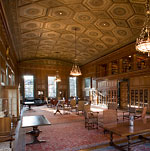Michigan’s Bibliomaniac
William L. Clements (1861-1934) Went Mad for Americana—and Built his Alma Mater a Library to Show It. By J. Kevin Graffagnino
It was the moment all serious collectors live for. And so, on June 15, 1923, William L. Clements gladly gave his kingdom. Clements had pursued antiquarian Americana at a high level for two decades. Now his alma mater, the University of Michigan in Ann Arbor, would house his extraordinary collection, in a beautiful building Clements helped design. In his presentation remarks Clements paid homage to such great Americana collectors as John Carter Brown and James Lenox, and he expressed the conviction that with the opening of his library, Ann Arbor would attract a large number of serious students of early American history. “Inspiration and written expression in full measure will come from those who see and use such books,” he said, “along with a realization of the great things they stand for, and the pivotal events they first narrate.”
By the early 1910s, Clements had caught the Americana bug in a serious way.
Clements loved the rarities he had accumulated, and he was confident that future generations would share his fascination. But true to form he placed some limits on that fascination: he didn’t want Michigan undergraduates or “the ordinary graduate student” rifling through his collection; in fact, in his dedication remarks Clements said he’d be happy if only “a handful of eminent historians” used the collections annually. After the ceremony he wrote to his friend Worthington C. Ford, a historian who directed the John Carter Brown library from 1917 to 1922: “I have returned home to a house empty of nearly all books, so it is needless to tell you how totally lost I am.”
William Lawrence Clements was born in Ann Arbor on April 1, 1861, the sixth and last child of James and Agnes Clements. James Clements was a gas engineer with interests in several Michigan cities, and on graduating from the University of Michigan in 1882 with a degree in engineering William began work at the Bay City Industrial Works, in which his father was a principal investor. Young Clements became manager of the company in 1883, and in the succeeding decades he made the company a national leader in the manufacture of steam shovels and other heavy railroad equipment. By the time he turned 50 he was moderately wealthy, chief investor in the First National Bank of Bay City, and a member of the University of Michigan board of regents.
Clements began his collecting career later in life than most bibliophiles. He filled his home in Bay City with an assortment of everyday books in the 1880s and ’90s, and then in 1903 he bought the Americana collection of Civil War veteran and Bay City merchant Aaron J. Cooke. Because Cooke and Clements were close friends, as the older man neared the end of his life he welcomed the opportunity to transfer his books to Clements. According to Margaret Maxwell’s 1973 biography Shaping a Library: William L. Clements as Collector, Cooke’s library was “rich in Americana and other volumes from the sales of Brinley, Barlow, Menzies, and other great 19th-century book collectors,” so acquiring the 1,000 Cooke volumes gave Clements a strong foundation on which to build. At the age of 42, he had the money, leisure and inclination to make the most of this good start, and in the remaining three decades of his life he did just that.













